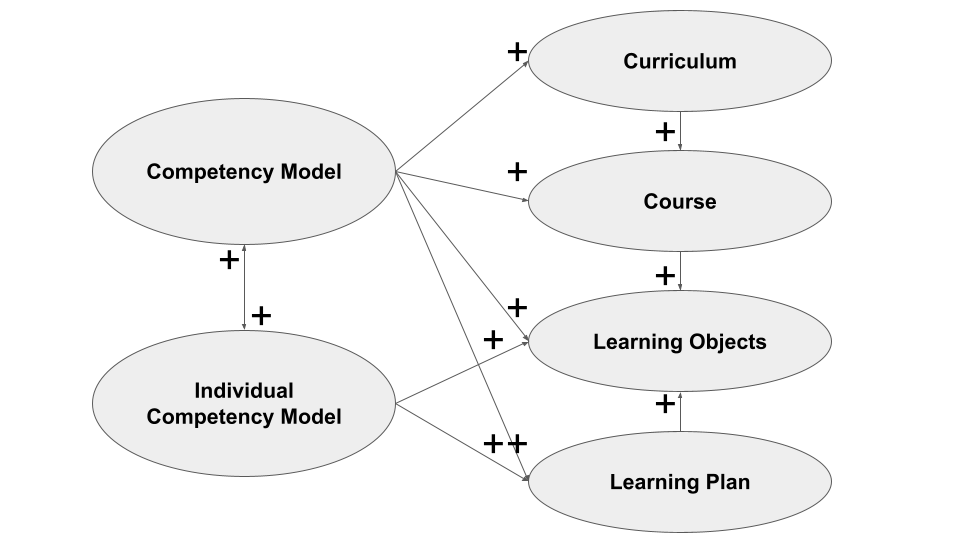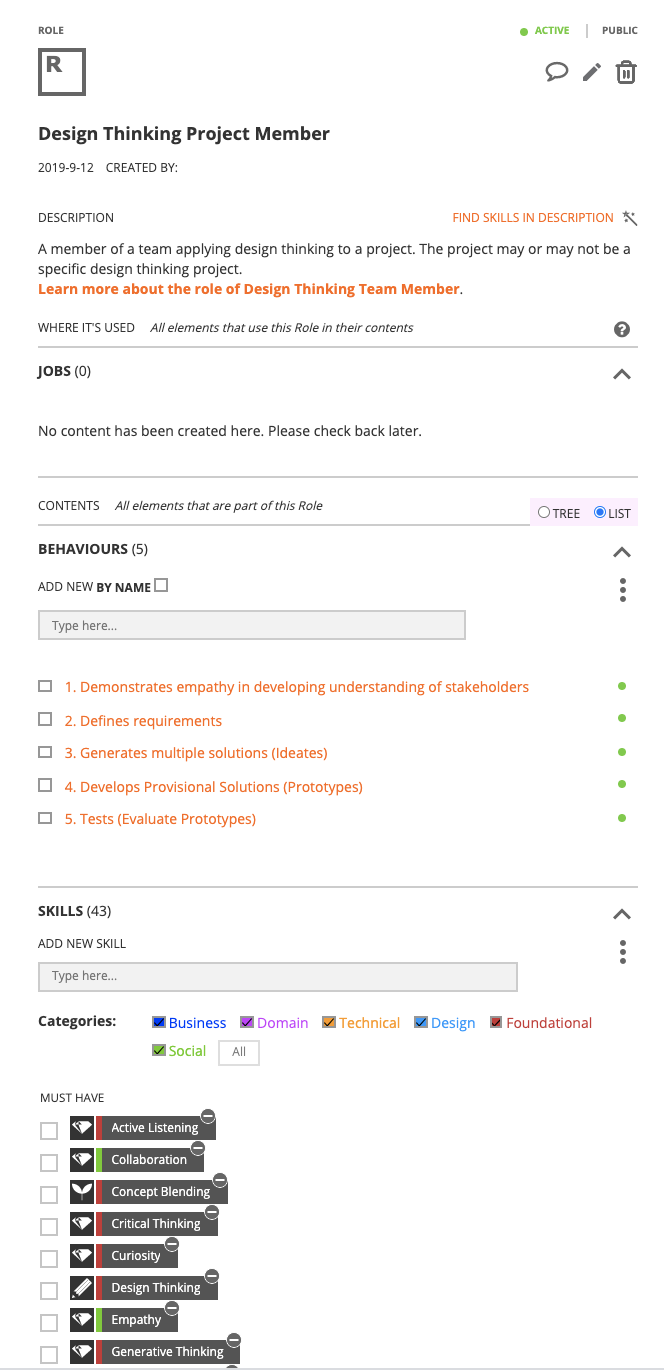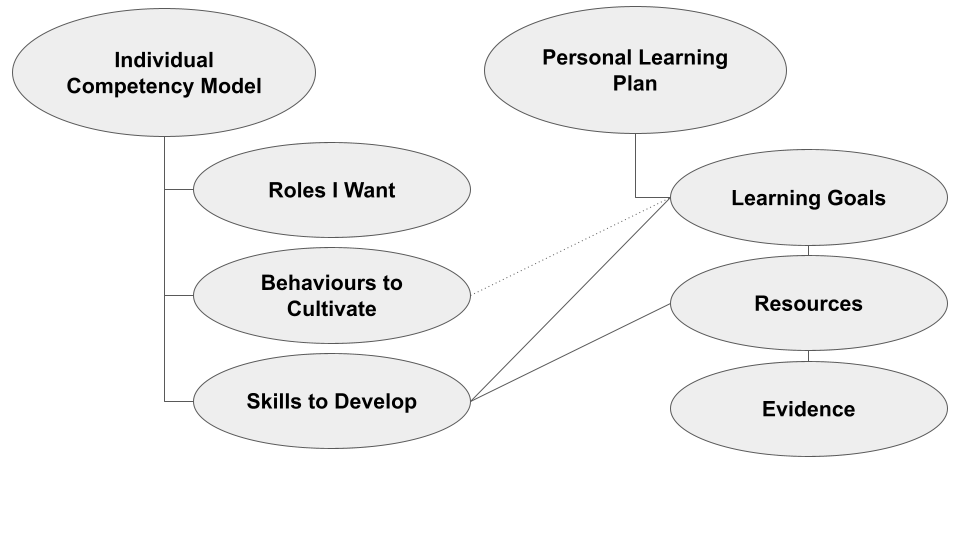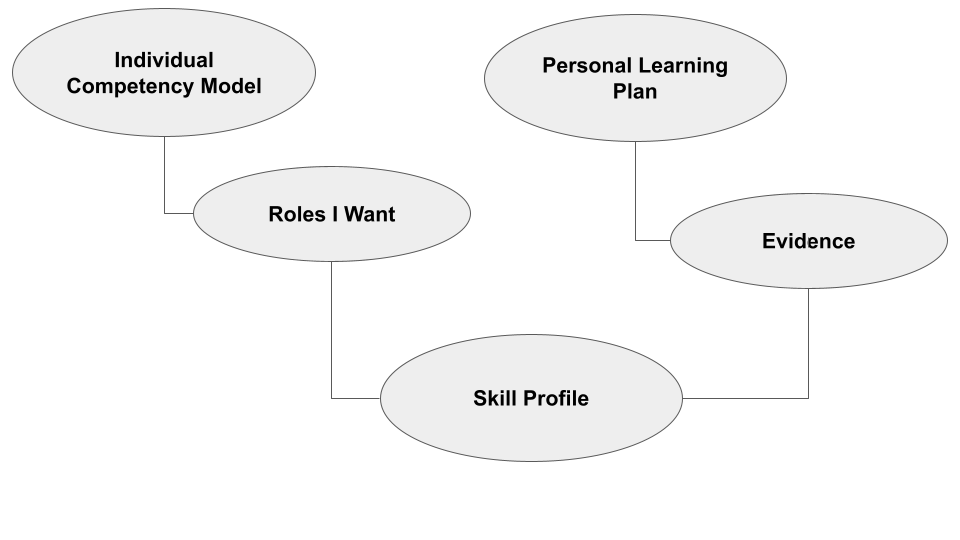Competency models and learning plans
Steven Forth is co-founder and managing partner at Ibbaka. See his skill profile here.
One common use of competency models is to inform curriculum development and instructional design. The competency model or framework becomes the source and one or more curriculums are built from this. Learning plans then support the curriculum, referencing the competency model.
That is the traditional best approach anyway. It is not always necessary or even desirable in an agile world. A good competency model should be rich enough to support learning directly. This is why many competency models include links to learning resources of various types.
Let’s explore the ways in which competency models support the development of curriculums and learning design and how a competency model can be used directly with an individual learning plan.
How are competency models, curriculums and learning plans related?
A competency model, as used in the business context where Ibbaka does most of its work, connects Jobs and Roles (roles can include a role in a job, on a project or an ad-hoc role) to the behaviors, tasks and activities needed for success. The competency required for success is usually defined through a set of KSA statements (Knowledge, Skills, Attitudes) and there is often a specific level of expertise specified for each of these statements.
For example, a competency statement for the role of design thinking project member might look like the below screenshot (this is taken from Ibbaka’s Open Competency Model for Design Thinking).
What does good learning design look like?
Learning and instructional designers have developed a rich approach to the design of curriculums and courses (think of a curriculum as collection of courses). The most common approach is referred to as ADDIE for Analyze, Design, Develop, Implement, and Evaluate.
Analyze - Understand the goals, target audience or persona, obstacles to learning, learning styles, prior knowledge, etc.
Design - Prepare the course outline and learning objects, learning goals, assessments, metrics, etc.
Develop - Develop the content - videos, interactives, infographics, written content, social interactions, links to external resources, microlearning schedules, etc.
Implement - Provision, register, integrate, publicize, support, nurture, evolve the course
Evaluate - See if the course is meeting its goals and having the intended impact, see if there are unanticipated impacts (good and bad)
In recent years, design thinking has emerged as an alternative or complement to ADDIE. Design thinking has a different cadence than ADDIE and is more iterative. It begins with developing a deep empathy with the user, their background and situation and what they are trying to achieve. Ibbaka has developed and maintains an Open Competency Model for Design Thinking.
Situated Cognition is an approach to designing learning that is also relevant to the design and implementation of competency models. It places learning in the larger environment in which the learning and subsequent performance will occur and incorporates recent advances in cognitive science. It is worth remembering that one definition of competence is ‘skill in context’ and this is a connection between competency modeling and current approaches to instructional design.
Sociocultural Learning is another important trend in learning design. In this case the social relations that learning and performance depends on our called out. This approach has its roots in the work of Soviet Era Russian psychologist Lev Vygotsky. The social dimensions of skills and competency models are underdeveloped, but this is changing as the importance of social skills in competency models is coming to the fore and competency models are being developed for team performance.
How are learning design and competency model design similar?
The ADDIE and design thinking approaches are applicable to skill and competency models as well as to education and training. In some cases, it even makes sense to develop the competency model and the educational model in parallel, having each influence the other.
The learning design discipline is more mature and better documented than competency model development. Ibbaka is conducting research into the design of competency models that will help to address this, and there is much for competency model experts to learn from learning designers. An example of this, mentioned above, is the importance of social relationships to both learning and to performance.
Skill and competency models can act as the connective tissue between organizational goals, job architectures, performance requirements and the training that is meant to support them. As discussed below, personal competency models and individual learning plans are also a good combination.
Your learning plan and your personal competency model
One approach to competency models that has been little explored is the personal competency model. Skill and competency models are often seen as large data structures designed at the level of the organization, profession or discipline. This does not need to be the case. Skill and competency models are a great way to structure a person’s thoughts on the roles they want to play and the skills they want to develop.
One can then use a personal learning plan as a way to develop the targeted skills and prepare for future roles.
A good learning plan has three key objects: Learning Goals, Resources that will help one achieve the goals and Evidence that the goals have been achieved. The main connection points are between Skills to Develop, the associated Learning Goals, and the Resources that support the learning. A resource can take many different forms, it could be a role on a project or an ad-hoc role in a community that gives opportunities to learn, a community of practice, a mentor or even a book or a conventional course. There is a meme in learning circles that 70% of learning comes from work experience, 20% from social interactions and only 10% from formal learning, the 70:20:10 model. Skill and competency models should also take the 70:20:10 approach into account.
The evidence from learning plans has a role to play in personal skill profiles. It is one way to show that one is developing the skills needed for the role you want.
Ibbaka posts on competency models and competency frameworks
Competency models as learning plans (this post)
From user experience to competency model design - Margherita Bacigalupo and EntreComp
Competency framework designers on competency framework design: The chunkers and the slice and dicers
Competency framework designers on competency framework design: Victoria Pazukha
Design research - How do people approach the design of skill and competency models?
The Skills for Career Mobility - Interview with Dennis Green
Lessons Learned Launching and Scaling Capability Management Programs
Talent Transformation - A Conversation with Eric Shepherd, Martin Belton and Steven Forth
Individual - Team - Organizational use cases for skill and competency management
Co-creation of Competency Models for Customer Success and Pricing Excellence
Competencies for Adaptation to Climate Change – An Interview with Dr. Robin Cox
Architecting the Competencies for Adaptation to Climate Change Open Competency Model
Integrating Skills and Competencies in the Talent Management Ecosystem
Organizational values and competency models – survey results






